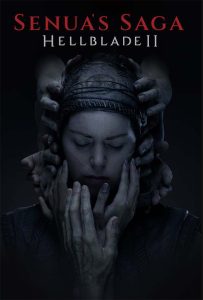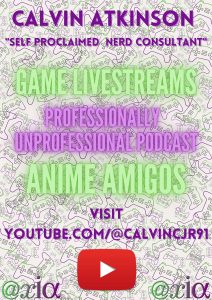Senua’s Saga: Hellblade II
(available for Xbox Series X & S and PC. Xbox Series X version used for Calvin’s review; PC version used for Elliot’s review)
So Hellblade 2 has been in development for a long time. I think that’s because it got a very early reveal; the game was first revealed at the game awards all the way back in 2019 as a big push for Xbox’s new console, which had just received its name announcement. Early on, it was being sold as the console for Halo Infinite and Hellblade 2. Thing is though, Ninja Theory clearly needed a lot of time to make this game and if anything, that trailer feels more like a hiring pitch.
Granted, I will stress that one thing that lengthened production was the change to Unreal Engine 5, and I believe that was well worth it.
If you haven’t played Hellblade 1, the game does start with a decent recap of that game, but I would still recommend actually playing the first Hellblade, Senua’s Sacrifice. If you have an Xbox, it is part of your Game Pass subscription, along with this game, and it’s not that long of an experience, both of these games last about 7 hours.
I knew that my co-reviewer Elliot was going to play the PC version of this game, so I took the Xbox version. I will say that the experiences do have one major difference, so depending on which version is feasible for you to purchase or download, you should choose that particular review. The big difference is the framerate. Xbox Series X and S both have the game at a locked 30FPS, and PCs can get the game up to 60FPS. The developers have stated that the 30FPS on consoles is due to wanting to make the game more cinematic, however based on things that I’ve heard, I have doubts about the validity of that… Based on statements made from podcasts like from ‘Modern Vintage Gamer’, it’s probably because the developers can’t currently get the 60FPS on consoles, or that it was outright decided on concept that 30FPS was going to be what they stick with.
I will say that on Xbox, there weren’t any framerate drops. But if you are a stickler for framerate and have both options available to you, the PC version is probably better for you. Though I personally think that this game runs pretty decently on Xbox because the game was designed around the 30FPS lock.
The game does take place immediately after the events of the first Hellblade, so I’ll be vague when I discuss the narrative, so I don’t give away any spoilers for that one. But needless to say, this game is basically a rehash of the first one. You’re pretty much doing the exact same thing as the first one, where you’re going from start to finish with the occasional combat and puzzles. Without going into too much detail, this game focuses on Senua being taken to what is now modern-day Iceland and fighting to deal with another set of obstacles based around Viking mythology.
PROS
- Visuals
Hellblade 2’s shift to the Unreal Engine 5 was the best decision that the development team could have made. This game is visually stunning. I have to say that photorealistic graphics don’t really impress me anymore, since I feel like they often lack an art style, but Hellblade 2 really has impressed me with how good it looks. By sticking to a linear narrative game, Ninja Theory has really designed an absolutely exquisite experience.
Some particular standouts for me in this department was the sequence in the caves, which do an excellent job using darkness to their advantage. I won’t go into too much detail about it, since I think you should experience it for yourself, but the team did an excellent job.
The character models also look excellent! They have done a brilliant job bringing the motion capture actors forward.
- Narrative
Hellblade 2 has one of the best narratives of the year so far, it’s a really good storyline. It takes the ending of Hellblade 1 and really does a decent job having Senua’s story continue in a way that doesn’t sacrifice the progression she had at the end of the first one. It’s basically about Senua taking the trials and tribulations that she had previously and can put them into something more constructive this time. It helps that we hear Senua’s inner voices again, which is why I highly recommend listening to this game with a headset, as it adds to the level of immersion.
I’ve seen people complaining about the game length, since if you’re speedy enough you can complete this game in about 5 hours, but realistically it takes about 6-7 hours. I think that this was perfect, because if it had taken any longer, I think the narrative might have stumbled, especially considering that you are playing this game via chapters, and you never return to areas that you have completed- you just move on to the next.
I did find the ending a bit vague in some areas, but how it delivers its overall message feels very apt with the current times.
MIXED
- Puzzles
One criticism that has been launched against Hellblade 2 is the puzzles. They’re a lot more linear than before. There are a few puzzles that can be very tedious and don’t quite work. I do, however, want to stress that none of them are terrible. I think that the cave has some of the best puzzles in the game, and some of them take advantage of the extremely fast load time that the Xbox Series X can deliver.
That being said, when they’re dead easy, they feel like minor obstacles. The puzzle methods definitely do repeat quite a bit, which is why they’re all in the mixed section.
- Combat
The combat is all completely one on one in this game, and I’ve heard some complaints about that- but personally, I think that it adds to the intensity of those combat situations, and I think that it leads to the gravitas of every move that Senua does. You’ve obviously got the focus mirror that essentially slows down your opponents, and of course, you’re going to be dealing with when to attack and when to parry. While I think the combat is intense, I think that this is when the framerate issue is really apparent, and it feels like these segments were aimed for the higher framerate. It made early combat a bit difficult to figure out, especially since it was a while since I played the first Hellblade.
In my opinion, while the combat is fine, I think this might be the one place where the framerate lets it down.
It’s also really hard to die in combat! I think I died only twice the entire time in the game via combat- this is definitely one where Ninja Theory wanted you to experience the story.
CONS
- Post-Game Features
Because Hellblade 2 is so incredibly linear, they do try to add some replay value, such as alternate paths and new narrators for a second playthrough. The problem is, I’ve already experienced the story at this point, and the game is so linear that these aren’t a good enough incentive for post-game content. This is a game where I might actually prefer my reward for completion to be behind the scenes footage or unlockable artwork. If that ever comes about from something you can do post-game, well I didn’t experience it. I did my playthrough and was in no mood to redo it with another narrator, especially considering that Hellblade has very heavy topics- especially around inner turmoil and mental health, to such an extent that I couldn’t play this game for too long and had to take breaks for this one.
I won’t bash the narrative, since it handles these subjects incredibly well, it’s just a personal thing! I just don’t feel that going back and playing the game through a different character’s perspective is a good reward.
FINAL THOUGHTS
Senua’s Saga Hellblade 2 is an excellent experience game. But I kind of feel like there are better games similar to this on the market. That being said, Hellblade 2 did all that it needed to- it’s an excellent sequel. I feel like a lot of reviews for this game centre on what it could have been rather than what it is and what it was meant to be. Personally, I think it was really good! But it also feels like it was a one-and-done game, I don’t think I’m ever going to revisit it. But I do hope that this does well so that Ninja Theory can make more games like this, maybe even a Hellblade 3.
If you’ve seen this game on Steam and feel like this is too much for you in terms of price, I recommend reading Elliot’s version of this review, since he actually played the PC version. This was purely based on the Xbox version, but I would also say you might want to wait for a price drop! I personally think that the game is priced at the right amount, given what a visual spectacle it is.
As an experience, it’s great. As a game, I think it’s got some shortcomings, but overall, it’s pretty damn good.
FINAL SCORE: 8/10
Director of Axia ASD Ltd.
Self-proclaimed Nerd Consultant
and Head of Axia’s Film Society.
And now Elliot’s review
2017 was a very good year for gaming, that year we saw the releases of heavy hitters like The Legend of Zelda: Breath of the Wild, Nier Automata, Persona 5, and many other GOAT level games. And of all those games, Hellblade: Senua’s Sacrifice was one of the most unique: a linear narrative driven game about the titular character descending into the Norse Underworld, Hell, to try and bring back a lost love, containing depictions of trauma, depression and grief told in a very unique way. The game became one of the hidden gems of that year, being applauded for how it represented mental health and its unique method of storytelling. It’s one of those games that you wouldn’t really expect a sequel for, and yet in 2019 we got the announcement of Senua’s Saga: Hellblade II, a continuation of Senua’s journey that I don’t think many people were expecting but was still welcome all the same. Senua’s Saga: Hellblade II was developed by Ninja Theory and released on 21st May 2024 for Xbox Series X/S and Windows.
Story
The story starts off with Senua on a slave ship on its way to Iceland, having been willingly captured to try and free others who have been enslaved. The ship finds itself in a storm and is destroyed as a result, with Senua being washed ashore. She encounters a number of the slavers, slaying them one by one before she encounters and defeats the leader of this band of slavers, Thórgestr, who’s then taken prisoner and forced to lead our hero to the other slaves. While journeying, Senua finds and frees a man called Fargrímr, which causes the group of Draugar to summon the giant Illtauga, who tries to stop the two but luckily, they manage to escape. Believing that she may be a seer, Fargrímr instructs Senua to seek out the Hidden folk, believing that they hold the key to slaying the immortal giant. However, even though she managed to escape from Hell, it seems that Senua’s traumas are far from finished with her.
The story is definitely different from the first game, going for more of a chosen hero journey based within Norse mythology rather than a dive into one’s psyche. Not that I’m complaining, the story of this game is still very good, Senua is still a very compelling protagonist, refusing to give up, no matter how much she suffers, both mentally and physically. I will admit that I do prefer the first games’ story, I felt more attached to Senua struggling with mental turmoil and I found that her issues with trauma were better represented in that game, also I found that there were some story beats that I think could have been shown better. But as a whole this is still a very good narrative.
Presentation
Simply put, this game is gorgeous. Senua’s Sacrifice was already one of the best-looking games of the previous generation, even compared to this generation it still looks fantastic, but this game is on another level. Every part of the character is meticulously detailed, the scars and imperfections on Senua’s flesh, the stitches in her clothing, the way the faces portray emotion, struggle and fury, every pixel is used to great effect, you could easily mistake the character models for being real people at times. This goes for the landscape as well, despite it being a very haunting game, the Icelandic landscapes are simply breathtaking, you can tell the developers spent a lot of time trying to capture the beauty of the mountains. And when things get dangerous, you better believe the environment perfectly matches it, bringing a miasma of threat and trepidation. This is one of the best-looking games of the generation, only rivalled in my opinion by Alan Wake II and Stray.
Seeing how good this game looks, you would probably expect a couple of frame drops, well luckily this isn’t the case. While there was the occasional chop when loading a cinematic scene, the frame rate remained very consistent throughout. There was a bit of controversy with this game when it came to FPS. It was reported not too long before the game came out that the Xbox version would be locked at 30FPS while on PC it would go up to 60. I played the PC version, and I can confirm that, while the 60FPS is greatly appreciated, it’s not entirely necessary. The battles are pretty slow paced and there are few mechanics that really require perfect timing. So, while it will definitely be a downgrade when it comes to immersion with the Xbox version, you’re certainly not going to be at a disadvantage.
And then there’s the voice acting, which is magnificent. Melina Juergens as Senua gives one of the best performances of the entire year, you really hear the struggle and anguish in her voice, while also being able to sound menacing when she has to, how she has only done voice work for Senua I have no idea because she is amazing. Everyone else is also great, Chris O’Reilly as Thórgestr and Steven Hartly as the Shadow are probably my favourites (outside of Juergens).
Just like the last game, Senua is afflicted with the voices of Furies that speak within her mind and comment on her every action or decision. This is why it’s highly recommended that you play this game with headphones, when played out in the open it can be seen as a cool effect and part of Senuas’ psyche, but when headphones are in it becomes incredibly eerie. The voices can sound like they’re coming from inside your head at times, with each one only taking up one of your speakers, making it feel more disorientating and incredibly immersive. Our head Nerd Consultant said that he couldn’t play the game for more than a couple of hours because of how disorientating he found the furies, so you can tell how well it works.
Heilung, a folk band that specialise in haunting, ambient melodies based on “runic inscriptions”, was heavily involved with this games’ soundtrack. Anyone who has heard Heilung, I’m certain, would agree that their sound would fit a Nordic setting perfectly, and I’m happy to say that they are the perfect pick for this game. A number of songs are very haunting, with droning notes, both instrumental and vocal, that sound like they’ve come straight out of shows like Vikings and The Last Kingdom (can you tell I have a bit of a Viking obsession). And while battles aren’t common, the music used in them is very memorable. The songs are very menacing, still having long notes in the instruments, but also being accompanied by harsh drums and threatening chants, just listening to it makes you feel tense, actually fighting while it’s in the background has the potential to make the fight genuinely frightening at times.
Combat
There’s not really that much to say about combat so let’s just get it out of the way. Combat has been mostly unchanged from Senua’s Sacrifice; you target only one opponent at a time and have to focus on dodging and blocking incoming attacks while figuring out when the best time for you to strike is. Combat is exclusively melee focused, with Senua having a faster but weaker combo, and a heavier attack string that’s much slower. The differences of these attack strings are minimal and, if you’re like me, the attack you’ll use will mostly depend on how you feel or what you think might be a bit more effective – using faster attacks while the enemy is winding up their own or using heavy when you parry one of their combos for example. If your enemy is a bit of a distance away, you can hold down the sprint button to charge towards them, potentially getting you an early victory in the battle, while also risking you running straight into a draugar’s axe.
Most of the enemy’s attacks can be blocked – and possibly even parried if you block just before the attack strikes, interrupting their combo and giving them less of an opportunity to block – though attempting to block them all isn’t recommended. Your opponents have multiple opportunities to break your stance, almost guaranteeing you getting hit. When the Draugars’ weapon starts glowing red, that’s the time to stop blocking and start dodging, as I said, you can still block these but just one hit from these can break your stance so keep an eye on that blade. Of course, there will be encounters when blocking is impossible, mostly against opponents that like to breath fire in your face, so don’t get too comfortable with trying to parry everything.
Just like the last game you have a focus ability. Focus slows down time for your opponent, letting you interrupt the enemy’s attack or bypassing their block and allowing you to pull off a series of blows that ensure their death. If you’re knocked down, you can activate your focus to immediately get yourself back up. This could have easily been very overpowering, but it does take a good while to build itself back up, meaning that you can’t abuse it in every fight and will have to think a bit more strategically before using it.
One thing that is somewhat disappointing is how easy the combat is in this game compared to Senua’s Sacrifice. It took until I was about halfway through the game to figure out why, and that is that you only fight one enemy at a time here. In the previous game, you had a number of encounters where you would fight multiple enemies at once, it was never overwhelming but considering the fact that you can only focus on one enemy at a time, it made the battles much more dangerous and stressful. With you only having to fight one enemy at a time, it makes the encounters much less arduous; instead of juggling multiple enemies at once, and trying to decide which ones are best to attack, you instead just have to time your attacks and dodges, which is really easy to do, thus lessening the tension and making each fight feel less dangerous.
Puzzles
Just like last time this game is very focused on puzzles. These puzzles are still observation based, having you examine your surroundings to find the path forward. The main puzzle from the last game returns: a gate adorning a series of Nordic runes will prevent you from progressing and you must find objects in your immediate environment that must be focused on from the right perspective to make up the symbols’ shapes and move forward. These puzzles are much less common than they were last time, but they’re still very challenging and will require a lot of exploration before you’re even given a hint on what you need to focus on.
In fact, the most common puzzle in this game is of a new variant. It’s still observation focused but manages to be quite different. Floating in the air you’ll find a large silver bubble, or a series of bubble rings that make up one big one when looked at the right way, by focusing on these you’ll notice the environment around you change, platforms and rock formations will have shifted gravity, ones on the floor wrapping to the ceiling for example, or may just disappear altogether. These puzzles will require you to focus on these bubbles repeatedly, using their environment shifting properties to create a path forward or to reach the solution to other puzzles. These aren’t as challenging as the symbol puzzles but can still be quite head scratching at times, they can disorient you and make you question if you’re going the right way or possibly going in circles in the more complex variants, but in a good way I assure you.
Aside from those, there are a couple that only show up for one section and never again, such as having to carry a torch while navigating through water containing shadow creatures or having to stay in a spotlight to avoid detection from an army of enemies. These additions never outstay their welcome and are very enjoyable, they essentially add to the horror of this game and it’s quite effective at the right moments.
Linearity and Emptiness
One complaint that I’ve heard said consistently is how linear the game is. There’s nothing really to explore or any branching paths for you to go down, in each area there’s only one direct path for you to walk. Personally, I don’t really see what the problem is, yes there were more slightly open areas in Senua’s Sacrifice, but that game in itself is very linear, so why people have an issue with this game but not that one, I have no idea.
What I do have a problem with is how barren the game can be at times. Now I’m not expecting every moment to be filled with battles and puzzles, that’s asking for way too much and it would get tiresome without the down time, but there are so many moments that are just filled with nothing. All you can really do in these moments is just walk down a path, listening to your allies debate and argue and hear your voices whispering doubts and assurances. I have no problem with spending time just walking through the Icelandic landscape, but these can last a bit too long. A few minutes is fine, but after ten you’re just wishing for a draugar attack.
While not as good as the first game in my opinion, I think that Senua’s Saga: Hellblade II is a very worthy continuation to the series. The usage of Norse mythology is expertly done, the puzzles are still a lot of fun, if a bit simple at times, and even though some people really don’t like the combat in these games, I really do and I think this games combat is very enjoyable. It’s up for debate if a game you can beat in 6 hours is worth the asking price, but in my opinion it absolutely is.
8.7/10
Anime Amigo and Nerd Consultant
Share This Post:








Leave a Reply